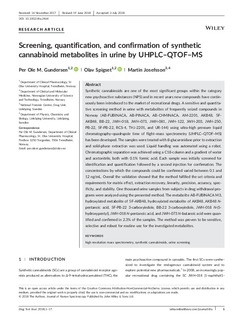| dc.description.abstract | Synthetic cannabinoids are one of the most significant groups within the category new psychoactive substances (NPS) and in recent years new compounds have continuously been introduced to the market of recreational drugs. A sensitive and quantitative screening method in urine with metabolites of frequently seized compounds in Norway (AB‐FUBINACA, AB‐PINACA, AB‐CHMINACA, AM‐2201, AKB48, 5F‐AKB48, BB‐22, JWH‐018, JWH‐073, JWH‐081, JWH‐122, JWH‐203, JWH‐250, PB‐22, 5F‐PB‐22, RCS‐4, THJ‐2201, and UR‐144) using ultra‐high pressure liquid chromatography–quadrupole time of flight–mass spectrometry (UHPLC–QTOF–MS) has been developed. The samples were treated with ß‐glucuronidase prior to extraction and solid‐phase extraction was used. Liquid handling was automated using a robot. Chromatographic separation was achieved using a C18‐column and a gradient of water and acetonitrile, both with 0.1% formic acid. Each sample was initially screened for identification and quantification followed by a second injection for confirmation. The concentrations by which the compounds could be confirmed varied between 0.1 and 12 ng/mL. Overall the validation showed that the method fulfilled the set criteria and requirements for matrix effect, extraction recovery, linearity, precision, accuracy, specificity, and stability. One thousand urine samples from subjects in drug withdrawal programs were analyzed using the presented method. The metabolite AB‐FUBINACA M3, hydroxylated metabolite of 5F‐AKB48, hydroxylated metabolite of AKB48, AKB48 N‐pentanoic acid, 5F‐PB‐22 3‐carboxyindole, BB‐22 3‐carboxyindole, JWH‐018 N‐(5‐hydroxypentyl), JWH‐018 N‐pentanoic acid, and JWH‐073 N‐butanoic acid were quantified and confirmed in 2.3% of the samples. The method was proven to be sensitive, selective and robust for routine use for the investigated metabolites. | nb_NO |

